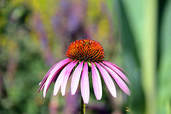|
Ozark Green Thumb BCMG Monthly e-Newsletter |
|
|
 All of our garden flowers originated as wildflowers. Most were developed by breeding and selection during the gardening explosion that occurred in Europe between 1820 and 1870. Not surprisingly, in the current gold rush mania that gardening has become in the last decade, plant breeders have again gone back to the wild to look for new garden plants. In the last decade, breeders have reinvented one of these – the coneflower – to produce stunning new perennials with totally new colors. Save one, all of the six or so recognized species of coneflowers (Echinacea) are found in the Ozarks. Most are prairie plants or glade dwellers in the open woodlands. The purple coneflower (E. purpurea) has long been grown in gardens with the other species mostly left alone in the wild, at least until recently.
Beginning in 1997, Dr. Jim Ault of the Chicago Botanic Garden, began hybridizing coneflowers. He crossed the familiar purple coneflower with E. paradoxa, the yellow coneflower found in limey soils of the southern Great Plains. The several hundred seedlings produced from this first-hand cross were uniformly purplish pink. These initial hybrid seedlings - the F-1 hybrids in breeding parlance - were crossed amongst themselves and seed saved. This second generation (the F-2 generation) flowered for the first time in 2001. These seedlings segregated into a rainbow of colors ranging from pink to yellow and all shades in between. Many showed a distinctive orange color. From this population, 50 distinctive new color forms were selected. One of the best of these was Orange Meadowbrite, a 30- to 36-inch tall coneflower released in 2004. It’s like the typical purple coneflower in growth habit except for the unusual shade of its three inch wide flowers. Orange Meadobrite flowers from late May through early summer, producing blooms that are a unique shade of orange. Some call the color tangerine, which is close but still not exactly right. The color changes shades under different lighting conditions and as the blooms age. Because it has undertones of other colors besides orange, it blends well with other perennials. Uncharacteristically, Orange Meadowbrite flowers have a distinctive spicy orange fragrance. Orange Meadowbrite is a hybrid between the familiar purple coneflower and the yellow coneflower. It’s one of the many new hybrid coneflowers making their way into our gardens.Ault has produced upwards of 20,000 coneflower seedlings during the last decade and continues to release new introductions. Mango Meadowbrite (a branch sport of Orange Meadowbrite) was introduced in 2005. Ault’s 2006 release is Pixie Meadowbrite, an 18-inch tall, long flowering pink with E. tennesseensis parentage. He describes Pixie Meadowbrite as having “an incredibly long bloom time and small perky flowers”. Future releases from the Chicago program will include clones with plants having various shades of red, apricot and white. These new clones are mass produced in tissue culture and have become hot items amongst gardeners wanting the newest plant introductions. Other than requiring at least four hours of sunlight and good drainage, coneflowers are easy to grow. They do best in a rich soil and have good drought tolerance once established. Trimming off the blooms can encourage a later flush of flowers. But, because finches love to pick the seeds from the mature cones in the fall, many gardeners prefer not cutting the plants back after flowering. By: Gerald Klingaman, retired Extension Horticulturist - Ornamentals Extension News - July 28, 2006
0 Comments
Leave a Reply. |
Archives
April 2022
|
|
